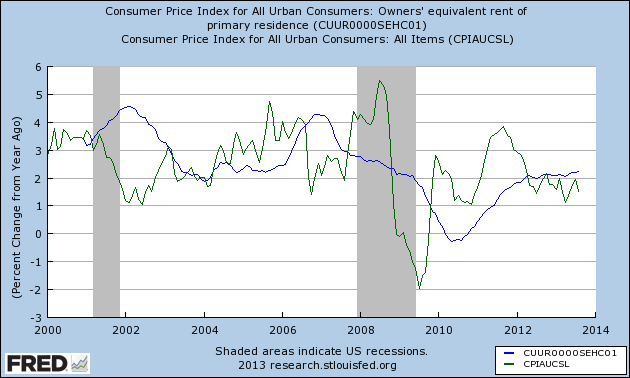October 06, 2013
Catherine Rampell has a piece in the NYT Magazine about how the 1 percent made out like bandits in the wake of the collapse of the housing bubble (wrongly described as the financial crisis). Several of the claims or implications of the piece are not quite right. For example, the piece claims:
“Rents have risen at twice the pace of the overall cost-of-living index, partly because middle-class families can’t get the credit they need to buy.”
This is not true. There has been little difference in the rate of rental price increases and the overall increase in the cost of living since the start of the crisis as shown below. (The green line is overall inflation, the blue line owners equivalent rent. Owners’ equivalent rent is the appropriate comparison since it excludes utilities.)

This should not be surprising since the switch of people from homeowners to renters coinciding with conversion of many ownership units to rental properties, which is discussed in the piece. While the former increased the demand for rental units, the latter increased the supply.
A second misleading point is the idea that house prices have recovered to their bubble peaks. This is not in general true. In markets where there was not much of a bubble house prices have largely returned to their 2006 peaks in nominal terms, which would correspond to roughly a 15 percent decline in real terms. In areas where the bubble was centered, like Las Vegas and Phoenix, prices are still well below bubble peaks even in nominal terms.
Finally the piece cites work by David Autor about the loss of middle wage jobs. This was not actually happening in the years prior to the downturn. While it is likely true in the years since the downturn, this almost certainly a standard cyclical story. High unemployment always takes a toll on middle and lower wage workers. Since people in Washington can’t talk about anything that will get us back to full employment (e.g. stimulus, a lower valued dollar, or work sharing), we are likely to continue to see workers in the middle and below take a big hit. But this is a policy decision, not the result of natural economic trends as is explained in the forthcoming book by Jared Bernstein and me (Returning to Full Employment: A Better Bargain for Working People, coming soon to a website near you.)







Comments